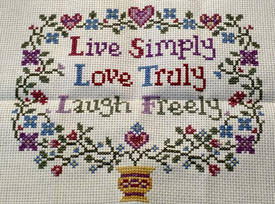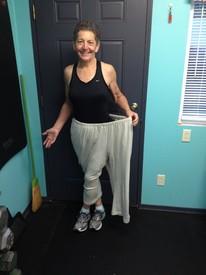Squats are painful

allft
Posts: 3 Member
Hi there I am new to this but thanks if your taking time to read this,
Whenever I do squats( I’m a beginner) it cause pain at the front of my knees around the calves, any help would be greatly appreciated! Thanks
Whenever I do squats( I’m a beginner) it cause pain at the front of my knees around the calves, any help would be greatly appreciated! Thanks
0
Replies
-
Are these weighted or body weight squats?
If you have a partner, have them check your form. Or video yourself so you can look at your own form.
If the problem is form, one good way to master squat form as a beginner is to start by doing box or chair squats. Put a box or chair behind you and squat back as if you are going to sit down. Touch, then lift back to a starting position. It can also help to begin with something other than a back squat with a barbell, such as a goblet squat - basically a goblet squat is holding a dumbbell by one end against your chest. Then start back squats with low weight - the bar without weights, or if that’s too much, use a broomstick. Add weight as long as your form remains good.
If your knees hurt even with good form, someone else will have to help you!
2 -
Try goblet squats with a nice wide stance, following these form tips:
https://www.builtlean.com/2016/11/30/goblet-squat-form/
Post an update. 2
2 -
I agree with rheddmobile, I learned good form by doing chair squats. Started with no weight (hands in praying position or on your hips), then added goblet or shoulder-racked weight. Only side note I can add is to also make sure your weight is even across your foot, not too much in toes or heel only.
Might help if you do a squat and try to hold lower position, then run a mental checklist of form like "do I feel weight in entire foot? Yes. Is my back straight and upright? Yes. Are my knees 90 degrees and not past my foot? Yes."0 -
rheddmobile wrote: »Are these weighted or body weight squats?
If you have a partner, have them check your form. Or video yourself so you can look at your own form.
If the problem is form, one good way to master squat form as a beginner is to start by doing box or chair squats. Put a box or chair behind you and squat back as if you are going to sit down. Touch, then lift back to a starting position. It can also help to begin with something other than a back squat with a barbell, such as a goblet squat - basically a goblet squat is holding a dumbbell by one end against your chest. Then start back squats with low weight - the bar without weights, or if that’s too much, use a broomstick. Add weight as long as your form remains good.
If your knees hurt even with good form, someone else will have to help you!
Everything rheddmobile is 100% correct. Your knees should not hurt doing squats. Bad form or weak hips can cause knee pain. I recently had hip replacement surgery and have been doing box squats to regain my strength back in my hip. Box squats are great for teaching you good form.0 -
Cherimoose wrote: »Try goblet squats with a nice wide stance, following these form tips:
https://www.builtlean.com/2016/11/30/goblet-squat-form/
Post an update.
Yup. goblet or sumo squats and limit your range of motion if need be to start with (you can even squat to a chair of that helps)
One thing I found that helped with my form when I first started was holding a light medicine ball at chest height and pushing it out away from my body as I went down into the squat (it helped with not rounding my back)
https://youtube.com/watch?v=UMsZ4XLgcWY
1 -
If your form is ok, you are probably really tight. Just keep doing as much as you can, with the modifications mentioned by others, and you will gradually progress over time.1
-
"Bad form" is way overblown. There simply isn't a definition of good form that adheres completely to everybody. Its sadly misused in the fitness industry left and right. I ask you reject the thought of bad form=pain.
Form isn't the cause of pain. Pain is way more complex than that. Pain is more than likely almost always a load issue.
If your squats are painful, use a combination of load, stance, range of motion, or variation that you can tolerate and work towards a full range of motion eventually. If all the above is not helping the issue(rare) I suggest trying a different lift for a while that is suitable for your goal.7 -
"Bad form" is way overblown. There simply isn't a definition of good form that adheres completely to everybody. Its sadly misused in the fitness industry left and right. I ask you reject the thought of bad form=pain.
Form isn't the cause of pain. Pain is way more complex than that. Pain is more than likely almost always a load issue.
If your squats are painful, use a combination of load, stance, range of motion, or variation that you can tolerate and work towards a full range of motion eventually. If all the above is not helping the issue(rare) I suggest trying a different lift for a while that is suitable for your goal.
It may be overblown, but to dismiss is going equally far in the other direction. I have a very broad range of what I consider “acceptable form” (so maybe we don’t disagree that much). However, if you don’t have a decent hip hinge and you put your weight forward on your knees, that is indisputably “bad form” and it will lead to knee discomfort or pain, even with no load.
3 -
Have you tried technically easier forms of squat? Hack squats on a machine, for example.1
-
"Bad form" is way overblown. There simply isn't a definition of good form that adheres completely to everybody. Its sadly misused in the fitness industry left and right. I ask you reject the thought of bad form=pain.
Form isn't the cause of pain. Pain is way more complex than that. Pain is more than likely almost always a load issue.
If your squats are painful, use a combination of load, stance, range of motion, or variation that you can tolerate and work towards a full range of motion eventually. If all the above is not helping the issue(rare) I suggest trying a different lift for a while that is suitable for your goal.
It may be overblown, but to dismiss is going equally far in the other direction. I have a very broad range of what I consider “acceptable form” (so maybe we don’t disagree that much). However, if you don’t have a decent hip hinge and you put your weight forward on your knees, that is indisputably “bad form” and it will lead to knee discomfort or pain, even with no load.
I'd argue that since I'm on my toes during squats more times than not due to my long femors and a progressive joint disease I'm still squatting record squats in the USAPL pain free without discomfort during training and competitions. Furthermore never have a knee issue despite catching in baseball for 40 years while being on my toes for one or sometimes two games a day.
Is being on your toes optimal? No, but if you train with proper load, even on your toes...one isn guaranteed pain or discomfort like you suggest.
The body is remarkably adaptive to training if the load is correct.
Example: People often say on shouldn't lift with a rounded back because of "bad form" and will destroy your back. Yet every strongman competitor lifts a atlas stone with a rounded back. They have no issues because they train with a rounded back.
2 -
Make sure your calves aren't too tight and ankle mobility is in tact otherwise your knee will take most of the damage.1
-
Thanks everyone I will check out the exercises that you have posted, thanks a lot and I will update how it goes!
Thanks1 -
"Bad form" is way overblown. There simply isn't a definition of good form that adheres completely to everybody. Its sadly misused in the fitness industry left and right. I ask you reject the thought of bad form=pain.
Form isn't the cause of pain. Pain is way more complex than that. Pain is more than likely almost always a load issue.
If your squats are painful, use a combination of load, stance, range of motion, or variation that you can tolerate and work towards a full range of motion eventually. If all the above is not helping the issue(rare) I suggest trying a different lift for a while that is suitable for your goal.
A lot of what you said there is wrong. Bad form can certainly cause pain. In the squat a narrowed stance or insufficient turning out of the feet can result in hip impingement. Not going to below parallel can result in knee pain. Improper bar placement can cause neck pain. Wrong hand placement can screw up both wrists and elbows.
Bad form does not always cause pain, nor may good form be pain free, depending on the individual.
But to OP's original question - video your lifts from a 3/4 view from the rear, and ensure you can see at least one end of the bar at all times as well as your feet. From your description and in the absence of a video, it sounds like you may not be getting to parallel - that is, where your hip crease is below the top of the kneecap.
If you're not capable of getting below parallel without weights, you've got some work to be to be able to squat with a barbell.3 -
Perhaps you didn't read this portion of my post. We adjust for the individual, not conform to a theory of a "good form" fits all.CipherZero wrote: »"Bad form" is way overblown. There simply isn't a definition of good form that adheres completely to everybody. Its sadly misused in the fitness industry left and right. I ask you reject the thought of bad form=pain.
Form isn't the cause of pain. Pain is way more complex than that. Pain is more than likely almost always a load issue.
If your squats are painful, use a combination of load, stance, range of motion, or variation that you can tolerate and work towards a full range of motion eventually. If all the above is not helping the issue(rare) I suggest trying a different lift for a while that is suitable for your goal.
A lot of what you said there is wrong. Bad form can certainly cause pain. In the squat a narrowed stance or insufficient turning out of the feet can result in hip impingement. Not going to below parallel can result in knee pain. Improper bar placement can cause neck pain. Wrong hand placement can screw up both wrists and elbows.
Bad form does not always cause pain, nor may good form be pain free, depending on the individual.
If you're not capable of getting below parallel without weights, you've got some work to be to be able to squat with a barbell.If your squats are painful, use a combination of load, stance, range of motion, or variation that you can tolerate and work towards a full range of motion eventually.
My point I making is there is no definition of good form that works for all individuals. Some people need a wide stance, some don't. Some people need high bar, others low bar or in between.
There is no universal "this is good form and everybody must do it this way" otherwise you will feel pain or injure yourself. There is in fact universal good load management that literature suggests is considered one of the most important aspect of training.
I know and train many sprinters that utilize a 3/4" squat without ever mentioning knee pain. Once again, appropriate load within a goal is key.
I've also trained people with physical limitations of people who couldn't achieve depth at first. Never did they complain of pain because the load was inappropriate for their skill and ability.
If one prefers to squat with only a broomstick resting near your neck out of optimal position with hand in odd positioning, I'd hazard most people won't feel pain in their neck or elbows that would prevent them from continuing more reps. Why? Because the load isn't inappropriate for that sub optimal position.
There will always be adjustments we can make to help a lifter move more weight. If the load is appropriate though, we can train any way we want within the individual's limits without fear of this being the cause of pain. Other than of course trauma because of another person drop kicking the side of the knee during a squat under load.
5 -
I'm going to say what I always seem to say in threads like this...
If your form is good and you still feel pain, I'd suggest asking your doctor before you carry on. Maybe get referred to a physio if your doc thinks that's appropriate. There might be a reason for the pain, and you don't want to aggravate a problem by ignoring the warning signs.
6 -
Quoted for truth.glovepuppet wrote: »I'm going to say what I always seem to say in threads like this...
If your form is good and you still feel pain, I'd suggest asking your doctor before you carry on. Maybe get referred to a physio if your doc thinks that's appropriate. There might be a reason for the pain, and you don't want to aggravate a problem by ignoring the warning signs.2 -
Sorry I forgot mention the squats I do are with out weights, should of mentioned that at the beginning sorry but thanks for the responses1
-
Hi!
When I started out I have the same thing. Super painful and barely able to do a squat. My personal trainer did some research (she has a degree in Kinesiology and Health sciences) and she had me roll out my quads, hamstrings, and most importantly my IT bands (at the side of your thigh - when they are tight it causes referred pain in the knees) BEFORE doing any squats. Then after squats we did other weight lifting legwork. After my workout I’d do another 20 mins of painful rolling out with a foam roller and textured roller.
Google a bit about how to use a roller. In a pinch, I’ve even used a tennis ball. It’s amazingly effective. Even with perfect form I had pain and couldn’t do 3 squats. I thing used the roller and after rolling I was able to do 3 sets of 15! It’s only become better since then 0
0
This discussion has been closed.
Categories
- All Categories
- 1.4M Health, Wellness and Goals
- 398.2K Introduce Yourself
- 44.7K Getting Started
- 261K Health and Weight Loss
- 176.4K Food and Nutrition
- 47.7K Recipes
- 233K Fitness and Exercise
- 462 Sleep, Mindfulness and Overall Wellness
- 6.5K Goal: Maintaining Weight
- 8.7K Goal: Gaining Weight and Body Building
- 153.5K Motivation and Support
- 8.4K Challenges
- 1.4K Debate Club
- 96.5K Chit-Chat
- 2.6K Fun and Games
- 4.8K MyFitnessPal Information
- 13 News and Announcements
- 21 MyFitnessPal Academy
- 1.6K Feature Suggestions and Ideas
- 3.2K MyFitnessPal Tech Support Questions










